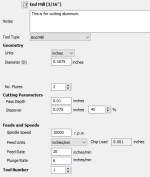- Messages
- 16,586
- Location
- Reno NV
So I'm planning on using my OX cnc to cut the holes in 4"x6"x3/4" piece of aluminum. The holes will be for some M8 screws, so a little bigger than 1/4".
I was planning on using a 2 flute carbide cutter to do the cutting.
From my research on these 'shapeoko' class machines, it's suggested to use a chipload of .001 when cutting aluminum. 5-10% of bit diameter for depth of cut, and 40% stepover with an rpm of 10000.
Does this seem reasonable? I'll find some aluminum to test on before I cut my plate, but would like to get this in the ballpark.

I was planning on using a 2 flute carbide cutter to do the cutting.
From my research on these 'shapeoko' class machines, it's suggested to use a chipload of .001 when cutting aluminum. 5-10% of bit diameter for depth of cut, and 40% stepover with an rpm of 10000.
Does this seem reasonable? I'll find some aluminum to test on before I cut my plate, but would like to get this in the ballpark.


